Balanced Nutrition for Chicken
Balanced Nutrition for Different Phases of Chicken
Published: September 6, 2012
By: Vuluvala Ramasubba Reddy (Avitech Nutrition Pvt. Ltd)
Balanced nutrition for different phases of chicken
The potential of the germ plasm in poultry available in India is manifested to the maximum, when the health and management of the flock is maintained. If either the nutrition or nutrient management is suboptimal, growth and egg production decline, increasing the cost of production. Higher nutrient specifications than required cause nutrient wastage, stress on the bird and increased cost of production.
Nutrition and Nutrient Management
Nutrition provides the cells of the system with all the nutrients required for physiological functions (e.g., growth, production, reproduction, immunity, etc.). Nutrient management includes all aspects concerned with providing nutrition to the bird right from ingredient selection, processing, mixing, storage, and delivery to the bird followed by intake and digestion and absorption of nutrients.
Nutrient Cost: The contribution of differentcomponents to the cost of ingredients in feed may be as follows: Energy and protein 90.0 %; Trace minerals 0.4%, Vitamins 1.0 %, Phosphorus 2.6% and other additives 6.0%. Phosphorus is economically the most important macro-mineral. All vitamins and trace minerals are generally added in higher quantity than the requirements/allowances. However, the contribution of these to the cost of feed is much less than the cost of energy, protein and phosphorus. Some feed additives are added as a prophylactic measure to obtain a specific or nonspecific nutritional or non-nutritional effect. The additives to maintain health can have a better effect provided management practices are adequate.
The feed additives and their function is given in Fig. 1 and their usage depending on the age group based on the experience of the author is given in Fig. 2.
Amino acids – Ideal amino acid profile
The protein in any ingredient or animal body is a polymer of amino acids, with specific configurations. The amino acids, about 20, are physiologically essential. Chicken has no ability to synthesize some of these physiologically essential amino acids either adequately or absolutely. These are termed as essential amino acids. Certain essential amino acids are likely to be low in practical feeds and these are known as critical amino acids. Lysine, methionine and threonine, which are available commercially, are the most deficient amino acids and are also referred to as limiting amino acids (Fig 3).
The nutrient requirement/allowances tables specify the amino acids to be provided in the feed at minimum. Amino acid interactions can occur due to imbalance, antagonism or toxicity leading to reduced utilization of amino acids. This can be minimized by following the ideal protein concept in feed formulation. In the ideal protein concept, an amino acid is selected as the reference amino acid and the requirements of all the other amino acids are expressed in terms of ratios to the reference amino acid. Lysine is selected as the reference amino acid in swine and poultry nutrition. The amino acids provided in the diet have to be digested for absorption. Digestibility of the same amino acid differs in different ingredients and the same feed ingredient has varied digestibility for different amino acids. The feed formulation based on digestible amino acids rather than on total amino acids is preferred for obvious reasons. Amino acid digestibility can be calculated as follows:

In a research study conducted by Hoeler et al (2006), both,AID and SID were used. SID values were found to be higher than AID values. The difference between AID and SID values was low for high protein ingredients (1 percentage point of lysine in soybean meal, CP 47% - 89 vs. 90%) and vice versa for low protein ingredients (7 percentage points for wheat, 13% CP - 79 vs. 86%).
NRC (1994) reported the requirement values based on scientific research. These are the minimum values without any margin of safety. Other agencies have suggested nutrient allowances based on their internal research and practical experience and have included margin of safety.
Different firms or organizations have expressed amino acid requirements/allowances as total and digestible amino acids. The digestibility coefficients for amino acids recommended by various breeding organiza-tions/agencies are generally found to be different and are also different for different phases of poultry. The digestion coefficients normally applied to convert total to digestible amino acids and vice versa are given in Table 1. Where both the digestible and total amino acids are given, the digestible amino acids are taken as the standard and converted to total amino acids. Where only methionine requirement is given, the methionine + cystine requirement is calculated assuming that methionine is 55% of methionine + cystine. All the values are given at ME content of 3000 Kcal/kg for broilers, 2800 Kcal/kg during growing period and at 2500 Kcal/kg during laying period for White Leghorn layers, and at 2800 Kcal/kg for broiler breeders.

Nutrient requirements for different phases of poultry
1. Broilers: Substantial research data is available onthe amino acid requirements/allowances of broilers. The amino acid requirements of broilers recommended by few agencies are given in Table 2. Hoehler et al. (2006) expressed the amino acids as SID values. The others (Ross (2007), Cobb (2004)), it is assumed, have expressed the amino acids as AID values. The digestible amino acids and total amino acids when converted to ME content of 3000 Kcal/kg, show wide variation. Hoehler et al. (2006) recommended the highest amino acid values, followed closely by Ross (2003) and Cobb (2004). NRC (1994) values are the lowest. An example of digestible lysine requirement is given in Table 3. At the same ileal digestible lysine content, methionine, methionine + cystine and threonine show lot of variation. These are also limiting amino acids.

NRC (1994) has reported the nutrient requirements for linoleic acid, vitamins, and minerals without any margin of safety (Table 4). Variable but much higher allowances were suggested in practical diets. The allowances of nonphytin phosphorus (NPP), Vitamin A, vitamin D 3 and vitamin E reported for Ross 308 (Ross, 2007) are much higher than for Cobb (Cobb, 2004). Wang et al. (2008) reported that broilers performed well when the trace mineral content was reduced to 20% of the industry norms (% reductions - mg/kg feed: copper, 2; iodine, 0.2; iron, 10; manganese, 20; zinc, 20).
It is possible to follow a wide range of nutrient allowances for broilers and reduce the trace mineral allowances. Trace minerals and vitamins concerned in immunomodulation may not be reduced to the minimum (e.g copper, selenium, zinc, vitamin A, vitamin E and C).
2. Layers: Growing period – A wide variation is seenin the requirements/allowances of all the amino acids, amino acid ratios to lysine (Table 5), phosphorus, trace minerals and vitamins (Table 6), during growing periods. NRC (1994) requirements are the total values for trace minerals and vitamins, while the other agencies have recommended supplemental levels. As evident in Table 5, during the starter period, the percent digestible lysine allowance suggested was 1.13 (0-3 wk) and 0.97 (3-9 wk) for Bovans; 0.98 (0-6 wk), 0.81 (6-9 wk) for HyLine W-36; 0.94 for BV 300, 0.95 (1-3 wk) and 0.82 (4-8 wk) for Lohmann Lite-LS. The requirement reported by NRC was 0.74% digestible lysine for 0-6 wk. Experiments conducted by Rama Rao and Ramasubba Reddy (unpublished) with WL chicks (0-8 weeks), increasing the protein and other amino acids (amino acids bearing a ratio with lysine) with increase in lysine content indicated a digestible lysine requirement of 0.712% (total lysine 0.8%), a value slightly lower than that of NRC (1994).
Differences of similar magnitude are also discerned during the latter part of the growing period (Table 5,6).
3. Layers: Laying period – The egg type chickenconsumes about 6 kg feed during the growing period and about 45-50 kg feed during laying. Any economization during laying period is of greater significance to the layer farmers.
The requirements/allowances of amino acids are calculated as g/b/d, during the laying period (Table 7). All the commercial agencies have recommended more digestible lysine when the production is high or during the earlier ages of egg production than in the later stages. This is termed as phase feeding. The methionine and methionine + cystine values also show much variation. The requirements/allowances suggested for other amino acids also are much higher than that of NRC (1994). The linoleic acid, mineral and vitamin requirements of layers during growing and laying period recommended by various agencies show much variation and are higher than the requirements of NRC (1994) (Table 8).
Information is not available in research literature for the phase feeding concept. Amino acid utilization during the earlier phases of production must be low to recommend higher values and must be high to recommend lower values during the latter phase. The bird lays the egg or does not lay the egg - an all-or-none principle. The concept of mathematical calculation for amino acid requirements for egg production is not tenable. Amino acids must be available for production of an egg/b/d, and the bird may not produce egg all the days, resulting in less than 100% production per day.
Recent research conducted by Rama Rao and Ramasubba Reddy (unpublished) on a good sample size of layers (8 x 84/diet; BV 300) during 61-68 weeks age, showed a digestible lysine requirement of about 0.58 g/b/d (total lysine 0.65 g/b/d). In this experiment, all the other amino acid values were increased with increase in lysine content of the diet in a ratio higher than the requirement known, keeping the lysine as the limiting amino acid. If lysine is limiting, the other amino acids are not utilized beyond the limit of lysine and have to be metabolized. The diets and the performance of the layers given in Table 9 and 10, show that digestible lysine requirement is 0.59 g/b/d (total lysine 0.65 g/b/d). Previously, with similar experimental model, Nageswara Rao and Ramasubba Reddy in 2000 (unpublished) at Hyderabad observed that the digestible lysine requirement of layers during the earlier phase of production is 0.614 g/b/d (total lysine 0.69 g/b/d).
Rama Rao et al. (1999) showed that WL layers (38-35 wks of age) require nonphytate phosphorus not more than 0.26 g/b/d.
4. Broiler Breeders: The requirements/allowances ofbroiler breeders during various stages of growth and production are much higher than egg layers. The intake of WL and broiler breeder layer for digestible lysine, digestible methionine+cystine and NPP are much higher than for WL layer (Table 11). The author has the experience of satisfactory performance from broiler breeders with an intake of digestible lysine of 0.88 g/b/d, digestible methionine+cystine of 0.77 g/b/d and nonphytate phosphorus of 0.32 g/b/d. Broiler breeder layer produces less number of eggs than WL layer.That the broiler breeder layer and WL layer differ in efficiency of nutrient utilization has not been indicated in the literature. Bhanja (2007) at Hyderabad, showed that broiler breeders performance with 0.12, 0.18, 0.24, 0.30, 0.36 and 0.42% non-phytate phosphorus from 25-44 weeks age (22.02.2001 to 13.06.2001) was similar with respect to egg production, egg weight, shell thickness, shell strength, fertility, hatchability, chick livability).
Wilson and Harms (1984) on experimentation with Cobb color-sex and Cobb feather-sex broiler breeders, reported that broiler breeder diets formulated to meet presently suggested requirements (g/b/d: Calcium 4.5; total Phosphorus, 0.75; Protein 23.0, Methionine + Cystine, 0.85) have a large margin of safety and suggested a reduction of specifications by approximately 10%. Very low protein diets (10%) appear to be adequate for broiler breeder females (Lopez and Leeson 1995).

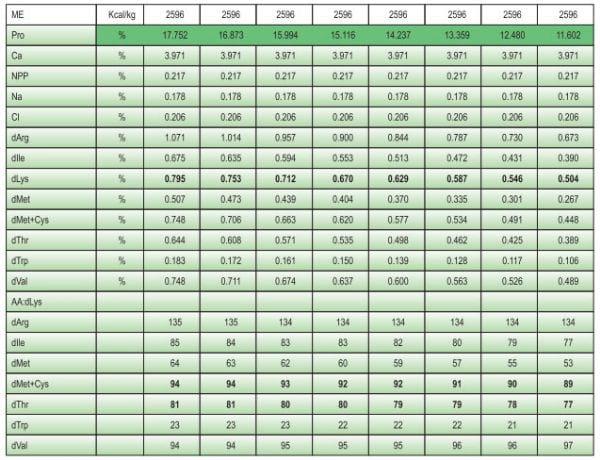
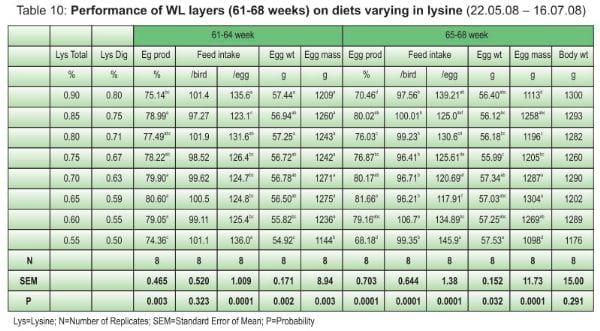
Areas of research required
Nutrient and cost economy for broilers and during laying period for egg type layers and broiler breeders can be affected because of the volume of feed intake and the cost. The areas of future research are indicated in Table 12. The amino acid requirements should be worked out on ideal protein concept.


Related topics:
Authors:
Avitech Animal Health
Recommend
Comment
Share
Recommend
Reply
Recommend
Reply

Would you like to discuss another topic? Create a new post to engage with experts in the community.
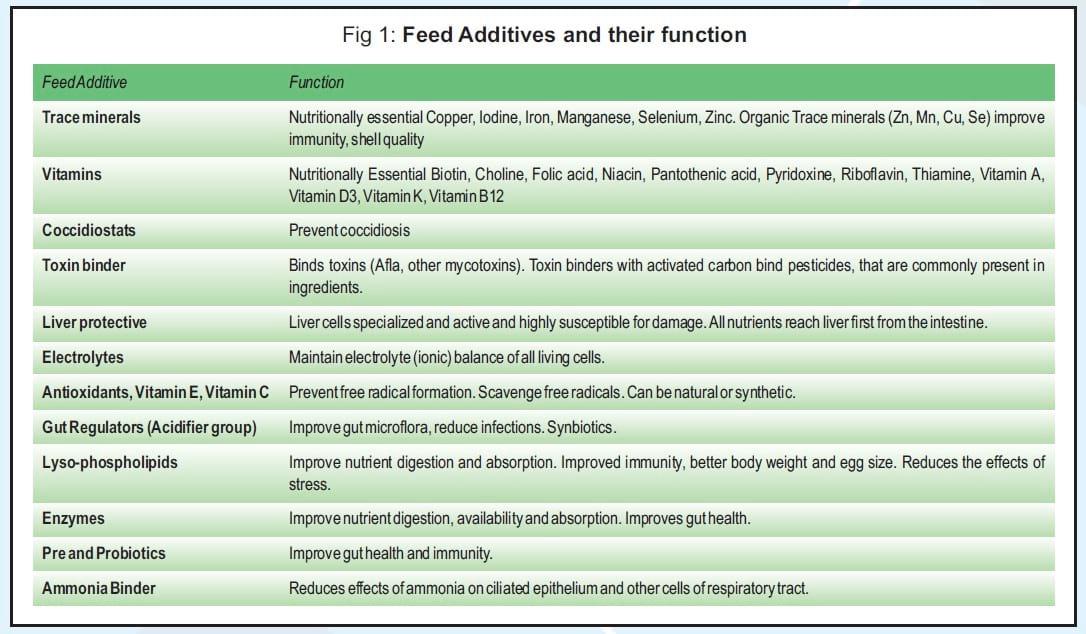
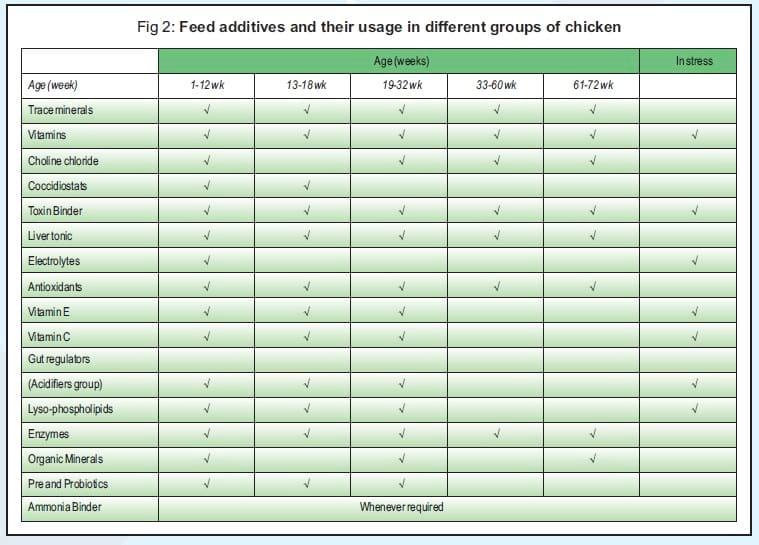
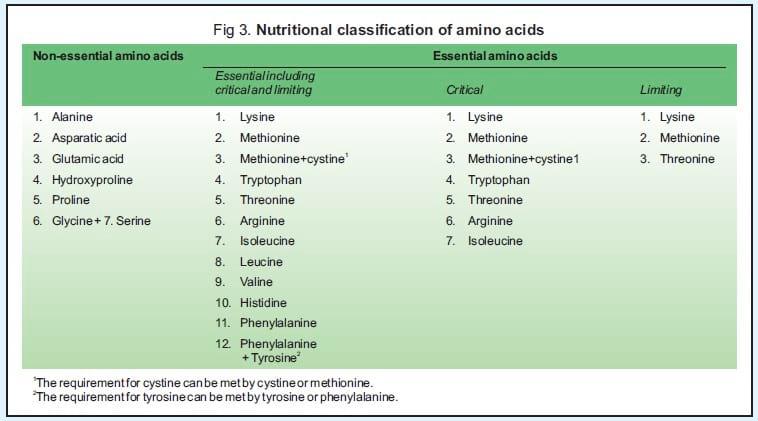

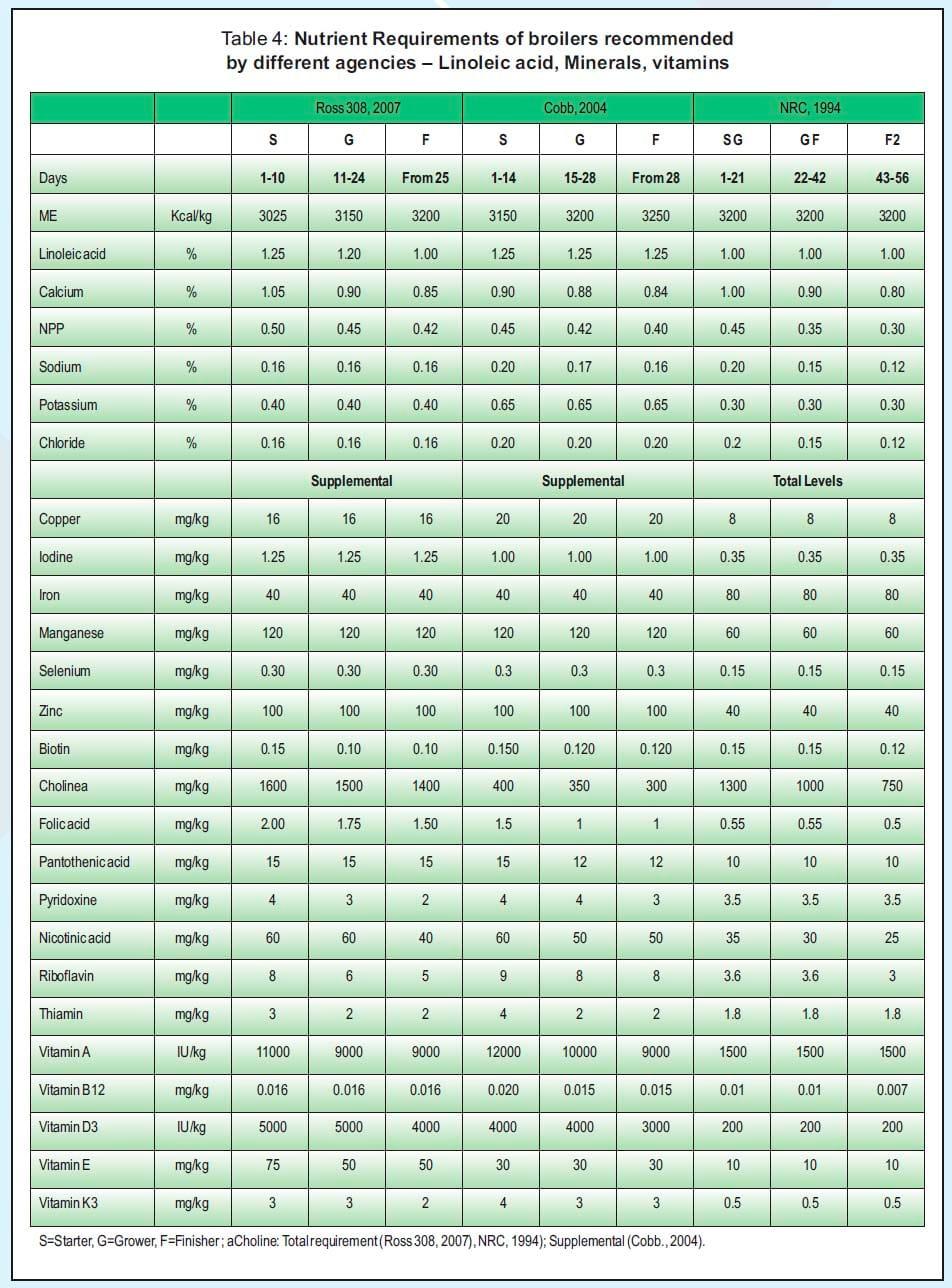

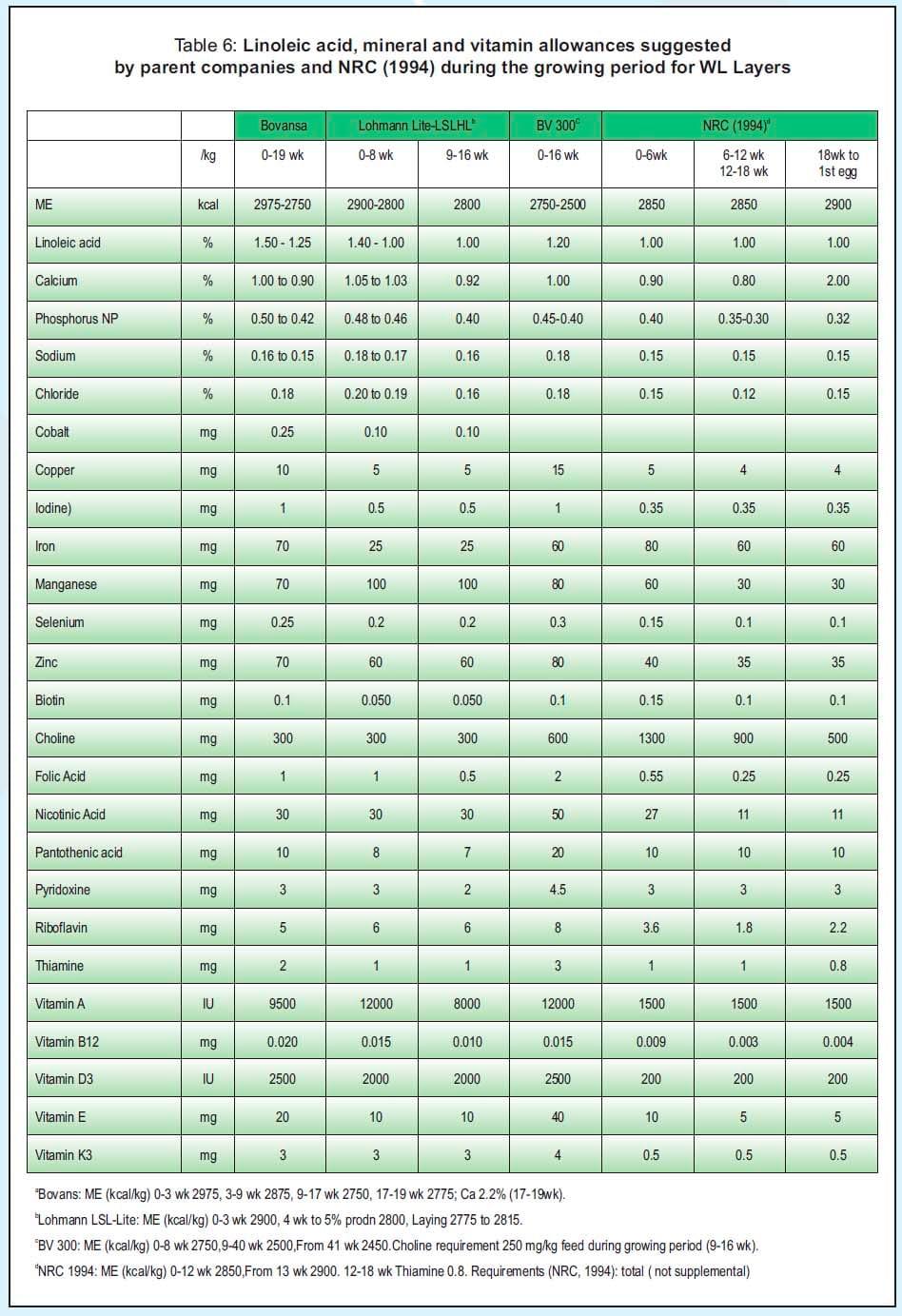

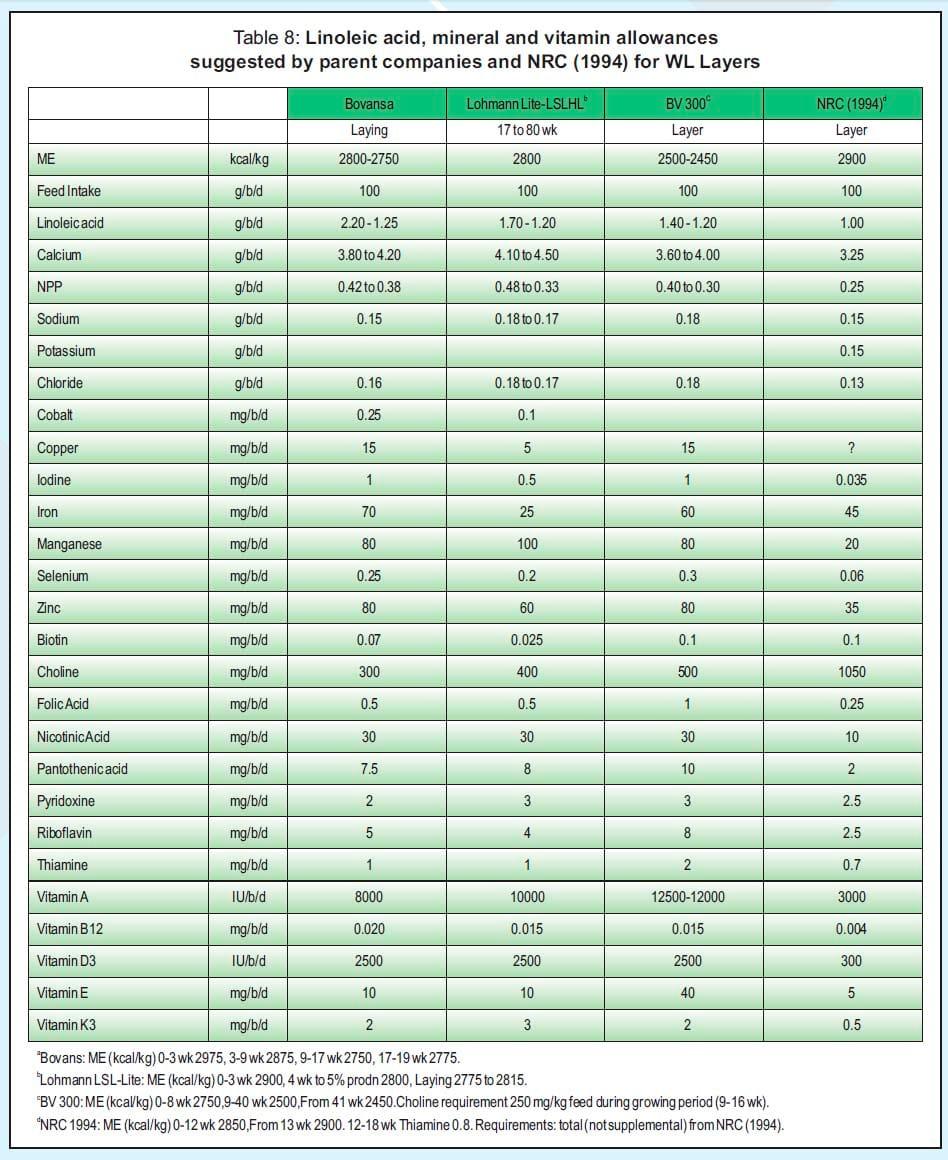









.jpg&w=3840&q=75)